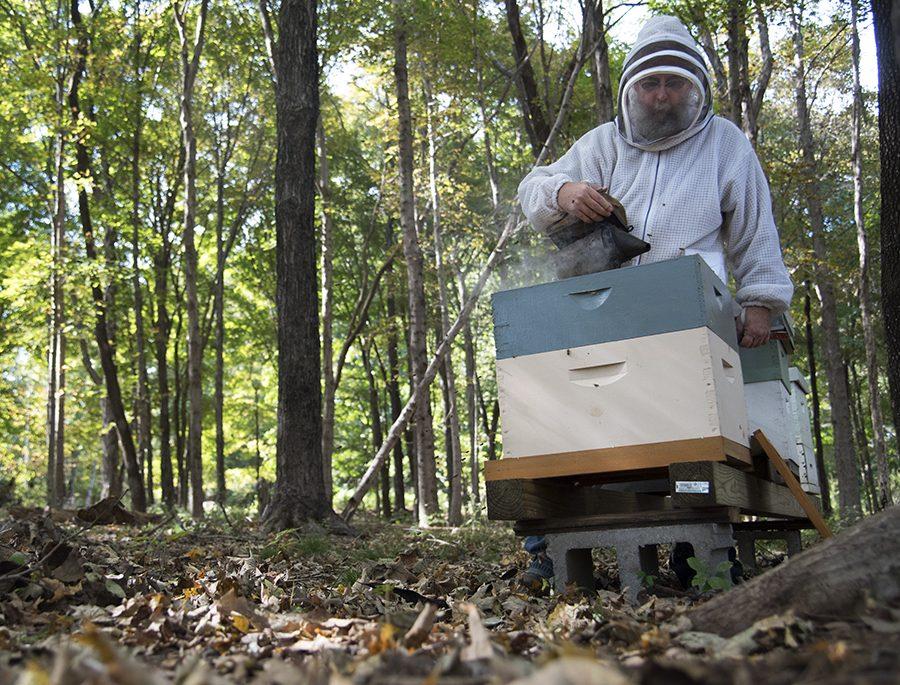Honeycombs and hives: Why this beekeeper says his job is the bee’s knees
Author and beekeeper Michael Bush, of Nehawka, Neb., inspects one of the frames from inside a beehive Sunday, Oct. 9, 2016, during the Southern Illinois Treatment-Free Beekeeping Seminar Series at Touch of Nature Environmental Center in Makanda. Bush has been keeping bees since the mid-1970s and today owns about 40 hives. “I just think [bees are] fascinating,” Bush said. “There’s always more to learn, always more to figure out. And there’s plenty of other people fascinated with bees too, so there’s all their research to read, books to read and books to write.” Bush is one of the leading advocates for treatment-free beekeeping. (Morgan Timms | @Morgan_Timms)
October 12, 2016
Thick white bodysuits and black screens covered the faces of about 20 individuals as they stood around three boxes of swarming honey-bearing insects.
These beekeepers gathered from across the region to learn from bee expert and author Michael Bush during an exclusive event Sunday at SIU’s Touch of Nature Environmental Center.
His visit spanned three days and included a presentation on treatment-free beekeeping and a field demonstration using Touch of Nature’s bee hives.
Advertisement
Before each hive was opened, a mixture of burning pine needles, leaves and denim fabric stuffed inside a “smoker” — a tool shaped like a watering can — was used to subdue the bees and keep them from attacking people.
“Over 7,000 years ago, people were using smoke with bees — and it works,” Bush said as he stood near the hives swarming with bees. “Even just having a smoker lit will affect their sense of smell.”
Honeycombs, pollen and bee larvae line multiple frames inside the wooden boxes the bees call home.
“There’s one thing about beekeeping you don’t want to be gentle about, and that is when you’re trying to get bees from one place to another,” Bush said as he used a tool to pry a frame loose. “When you’re trying to get them out of a box, being gentle doesn’t work.”
He then removed the frame — thickly coated with bees and shiny honey — from the box and displayed it to the audience.
The beekeeper did this with each hive, removing sections and pointing out interesting aspects, such as mold growing on the honeycomb, propolis — a wax-like resin that can be use as a health product — and “young broods,” or growing worker bees.
Advertisement*
He mentioned “hive beetles,” a pest that infiltrates and damages beehives. But, Bush said killing beetles “is more for the beekeepers than for the bees.” In empty spaces in the hive, the bees will trap the beetles using wax.
“Bees are just so fascinating,” he said. “Just as soon as you think you have them figured out, they surprise you.”
For those interested in beekeeping, there are numerous beekeeping groups in southern Illinois, accessible through the Illinois State Beekeepers Association. Bush said some people may quickly get sucked in.
“Maybe that’s what I should warn people about,” the beekeeper said with a chuckle. “It’s terribly addicting. Run away while you still can.”
Staff writer Hannah Cooper can be reached at [email protected] or on Twitter @hcooper_DE.
To stay up to date with all your SIU news, follow the Daily Egyptian on Facebook and Twitter.
More from the features section:
- Women in SIU automotive technology steer toward industry equality
- Nick Hill’s rise to SIU football’s head coach
- Deceased find new life through SIU body donation programs
- Recent SIU grad on the Olympics and what’s to come
Advertisement










Michael Cambridge Beekeeper • Oct 21, 2016 at 4:41 pm
I don’t agree that being gentle with bees doesn’t work! If you handle bees gently they do not react as badly as if you are rough with them! They do not see you as the aggressor unless you are aggressive. Smoke also used in a limited way helps, they don’t need to be smothered. Keep 20 hives full and have done for many years. Very rarely get stung, only if I do something wrong (such as being aggressive or rough in handling them!). I certainly agree that bees are fascinating, and looking after them is addictive.